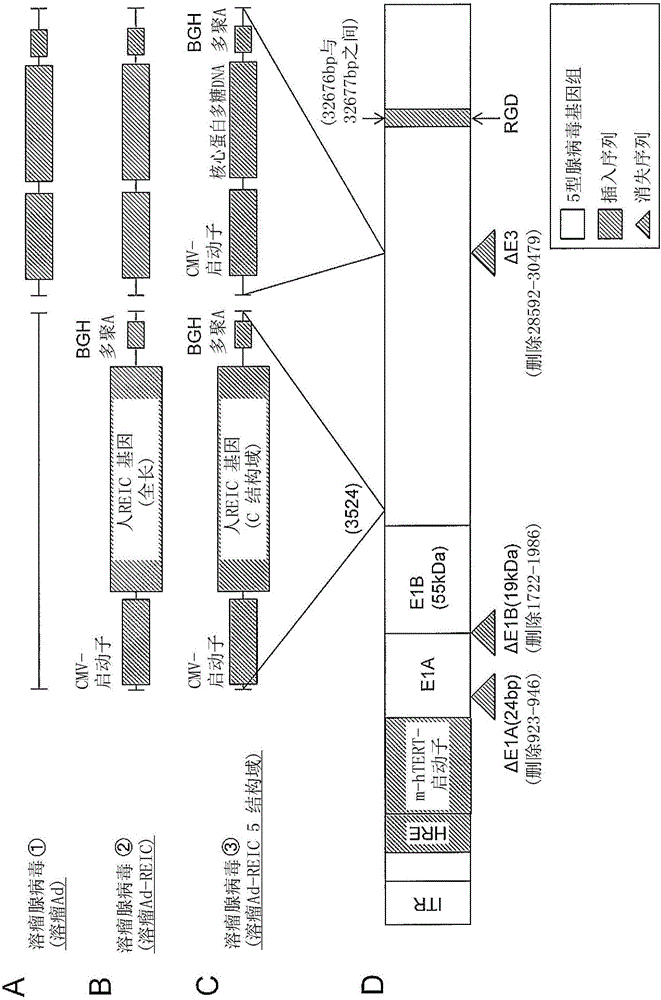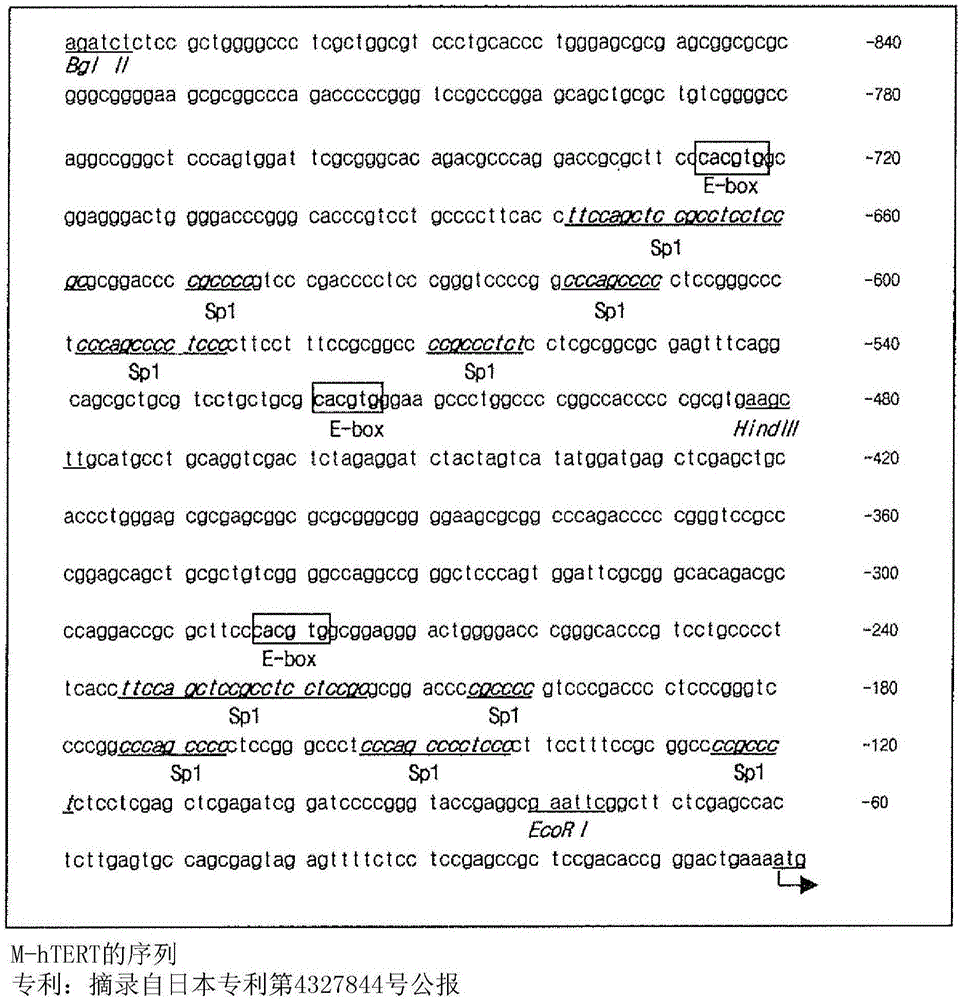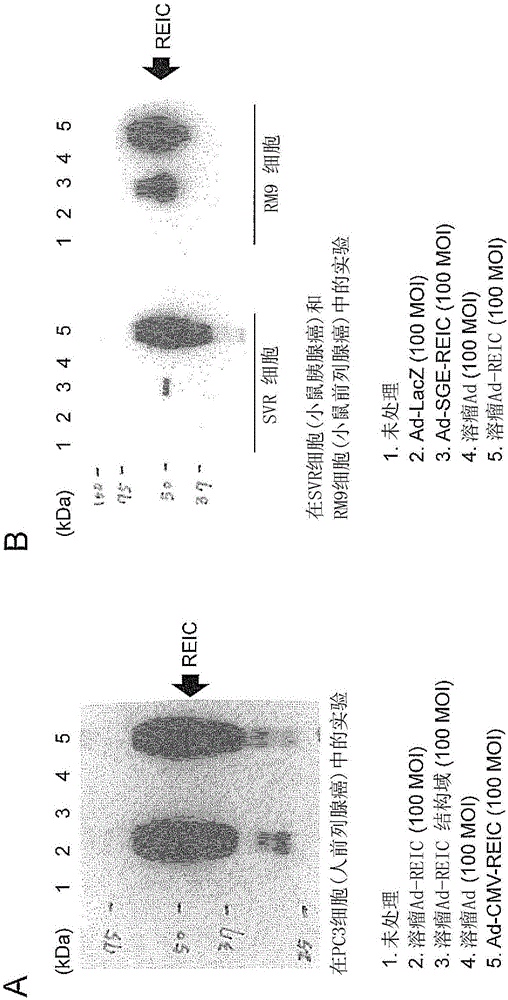Conditionally replicating adenovirus expressing REIC gene
An adenovirus, replicating technology, applied in the direction of virus, virus/bacteriophage, double-stranded DNA virus, etc., can solve the problems of disease progression, weakened anti-cancer immune function, and limit the therapeutic effect of T-VEC, and achieve a strong anti-cancer effect , the effect of strong therapeutic effect
- Summary
- Abstract
- Description
- Claims
- Application Information
AI Technical Summary
Problems solved by technology
Method used
Image
Examples
Embodiment 1
[0112] Example 1 Production of Oncolytic Adenovirus (Oncolytic Adenovirus: Oncolytic Ad)
[0113] In order to make oncolytic adenovirus expressing REIC or REIC C domain (REIC-C) and decorin (DCN) in the E1 region and E3 region respectively, pCA14Ad E1 shuttle vector expressing REIC or REIC C was firstly made. The REIC or REIC C gene was excised from pShuttole / REIC or REIC-C using NheI-blunt-HindIII and subcloned into pCA14Ad E1 shuttle vector previously digested with XbaI-blunt-HindIII. The pCA14 / REIC and pCA14 / REIC-C vectors were digested with BglII, and then the CMV-REIC-polA and AMV-REIC-C-polA expression cassettes were cloned into the pΔE1sp1B-HmT-Rd19 shuttle vector (Kim E et al., Hum Gene Ther 2003; 14:1415-1428; Kim JH et al., J Natl Cancer Inst2006; 98:1482-1493), pΔE1sp1B-HmT-Rd19 / REIC and pΔE1sp1B-HmT-Rd19 / REIC-C adenovirus E1 shuttle vector. The pSP72-E3 / DCN (I-KChoi et al., Gene Therapy 2010; 17:190-201.) E3 shuttle vector was linearized with XmnI and co-transfo...
Embodiment 2
[0116] Example 2 Expression of REIC protein in various cells caused by addition of oncolytic Ad, oncolytic Ad-REIC and oncolytic Ad-REIC domain
[0117] method
[0118] To measure REIC protein expression after Ad-REIC treatment, cells were seeded into flat-bottom 6-well plates and incubated for 24 hours. Using the MOI (multiplicity of infection, multiplicity of infection) recorded in the figure, the adenovirus was used to infect the cells in complete medium (300 μl) for 1 hour, and washed twice with PBS (phosphate buffered saline, phosphate buffered saline). Use lysis buffer (50 mM HEPES, pH 7.4, 250 mM NaCl, 1 mM EDTA, 1% NP-40, 1 mM DTT, 1 mM PMSF, 5 μg / ml leupeptin, 5 μg / ml aprotinin, 2 mM Na 3 VO 4 , 1mM NaF, 10mMβ-GP) were dissolved to extract the REIC protein.
[0119] After centrifugation, the supernatant was diluted with the same volume of 4×SDS sample buffer and heated at 95°C for 5 minutes. The samples (5 μg of protein) were separated on a 10% SDS-PAGE gel, and e...
Embodiment 3
[0123] Example 3 Confirmation of cell death induction rate in various cells by addition of oncolytic Ad and oncolytic Ad-REIC
[0124] method
[0125] To study the cytocidal rate after Ad-REIC treatment, cells were seeded into flat-bottom 6-well plates and incubated for 24 hours. The cells were treated with adenovirus in complete medium (300 μl) at the MOI (multiplicity of infection) described in the figure for 1 hour, and 1700 μl of fresh medium was added. After the number of days indicated in the figure, the dead cell rate (%) was determined by microscopic observation of 5 fields. It should be noted that, in Figure 4~6 In, data are presented as mean ± standard deviation. Tests for statistically significant differences were performed using scatter analysis or the Mann-Whitney U test. When p<0.05, it was judged to have a significant difference.
[0126] result
[0127] The cell death induction rate in various cells caused by the addition of oncolytic Ad and oncolytic Ad...
PUM
 Login to View More
Login to View More Abstract
Description
Claims
Application Information
 Login to View More
Login to View More - R&D
- Intellectual Property
- Life Sciences
- Materials
- Tech Scout
- Unparalleled Data Quality
- Higher Quality Content
- 60% Fewer Hallucinations
Browse by: Latest US Patents, China's latest patents, Technical Efficacy Thesaurus, Application Domain, Technology Topic, Popular Technical Reports.
© 2025 PatSnap. All rights reserved.Legal|Privacy policy|Modern Slavery Act Transparency Statement|Sitemap|About US| Contact US: help@patsnap.com



